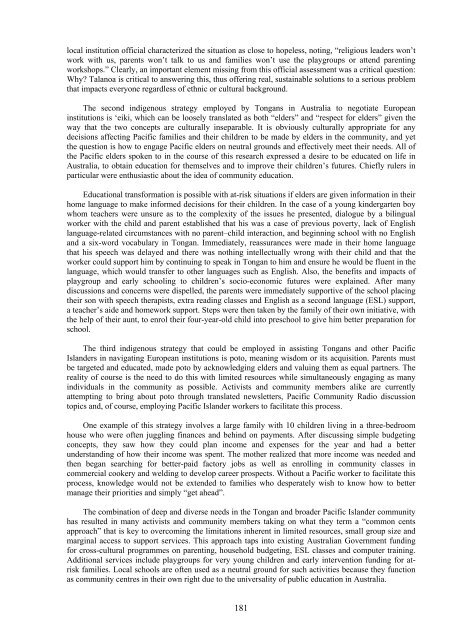traditional knowledge conference 2008 te tatau pounamu
traditional knowledge conference 2008 te tatau pounamu
traditional knowledge conference 2008 te tatau pounamu
You also want an ePaper? Increase the reach of your titles
YUMPU automatically turns print PDFs into web optimized ePapers that Google loves.
local institution official charac<strong>te</strong>rized the situation as close to hopeless, noting, “religious leaders won’twork with us, parents won’t talk to us and families won’t use the playgroups or at<strong>te</strong>nd parentingworkshops.” Clearly, an important element missing from this official assessment was a critical question:Why? Talanoa is critical to answering this, thus offering real, sustainable solutions to a serious problemthat impacts everyone regardless of ethnic or cultural background.The second indigenous stra<strong>te</strong>gy employed by Tongans in Australia to negotia<strong>te</strong> Europeaninstitutions is ‘eiki, which can be loosely transla<strong>te</strong>d as both “elders” and “respect for elders” given theway that the two concepts are culturally inseparable. It is obviously culturally appropria<strong>te</strong> for anydecisions affecting Pacific families and their children to be made by elders in the community, and yetthe question is how to engage Pacific elders on neutral grounds and effectively meet their needs. All ofthe Pacific elders spoken to in the course of this research expressed a desire to be educa<strong>te</strong>d on life inAustralia, to obtain education for themselves and to improve their children’s futures. Chiefly rulers inparticular were enthusiastic about the idea of community education.Educational transformation is possible with at-risk situations if elders are given information in theirhome language to make informed decisions for their children. In the case of a young kindergar<strong>te</strong>n boywhom <strong>te</strong>achers were unsure as to the complexity of the issues he presen<strong>te</strong>d, dialogue by a bilingualworker with the child and parent established that his was a case of previous poverty, lack of Englishlanguage-rela<strong>te</strong>d circumstances with no parent–child in<strong>te</strong>raction, and beginning school with no Englishand a six-word vocabulary in Tongan. Immedia<strong>te</strong>ly, reassurances were made in their home languagethat his speech was delayed and there was nothing in<strong>te</strong>llectually wrong with their child and that theworker could support him by continuing to speak in Tongan to him and ensure he would be fluent in thelanguage, which would transfer to other languages such as English. Also, the benefits and impacts ofplaygroup and early schooling to children’s socio-economic futures were explained. Af<strong>te</strong>r manydiscussions and concerns were dispelled, the parents were immedia<strong>te</strong>ly supportive of the school placingtheir son with speech therapists, extra reading classes and English as a second language (ESL) support,a <strong>te</strong>acher’s aide and homework support. S<strong>te</strong>ps were then taken by the family of their own initiative, withthe help of their aunt, to enrol their four-year-old child into preschool to give him bet<strong>te</strong>r preparation forschool.The third indigenous stra<strong>te</strong>gy that could be employed in assisting Tongans and other PacificIslanders in navigating European institutions is poto, meaning wisdom or its acquisition. Parents mustbe targe<strong>te</strong>d and educa<strong>te</strong>d, made poto by acknowledging elders and valuing them as equal partners. Thereality of course is the need to do this with limi<strong>te</strong>d resources while simultaneously engaging as manyindividuals in the community as possible. Activists and community members alike are currentlyat<strong>te</strong>mpting to bring about poto through transla<strong>te</strong>d newslet<strong>te</strong>rs, Pacific Community Radio discussiontopics and, of course, employing Pacific Islander workers to facilita<strong>te</strong> this process.One example of this stra<strong>te</strong>gy involves a large family with 10 children living in a three-bedroomhouse who were of<strong>te</strong>n juggling finances and behind on payments. Af<strong>te</strong>r discussing simple budgetingconcepts, they saw how they could plan income and expenses for the year and had a bet<strong>te</strong>runderstanding of how their income was spent. The mother realized that more income was needed andthen began searching for bet<strong>te</strong>r-paid factory jobs as well as enrolling in community classes incommercial cookery and welding to develop career prospects. Without a Pacific worker to facilita<strong>te</strong> thisprocess, <strong>knowledge</strong> would not be ex<strong>te</strong>nded to families who despera<strong>te</strong>ly wish to know how to bet<strong>te</strong>rmanage their priorities and simply “get ahead”.The combination of deep and diverse needs in the Tongan and broader Pacific Islander communityhas resul<strong>te</strong>d in many activists and community members taking on what they <strong>te</strong>rm a “common centsapproach” that is key to overcoming the limitations inherent in limi<strong>te</strong>d resources, small group size andmarginal access to support services. This approach taps into existing Australian Government fundingfor cross-cultural programmes on parenting, household budgeting, ESL classes and compu<strong>te</strong>r training.Additional services include playgroups for very young children and early in<strong>te</strong>rvention funding for atriskfamilies. Local schools are of<strong>te</strong>n used as a neutral ground for such activities because they functionas community centres in their own right due to the universality of public education in Australia.181
















